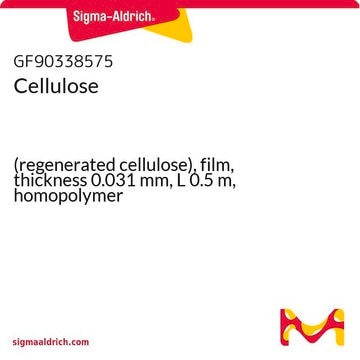推荐产品
種類
Type 101
形狀
fibers
InChI
1S/C12H22O11/c13-1-3-5(15)6(16)9(19)12(22-3)23-10-4(2-14)21-11(20)8(18)7(10)17/h3-20H,1-2H2/t3?,4?,5?,6?,7?,8?,9?,10-,11?,12+/m1/s1
InChI 密鑰
GUBGYTABKSRVRQ-WFVLMXAXSA-N
正在寻找类似产品? 访问 产品对比指南
應用
Sigmacell 纤维素用于薄层色谱法 (TLC) 和纤维素 TLC 吸附剂。Sigmacell 纤维素已被用于大规模纯化酶的工业应用研究,以及研究棘状青霉 的纤维素酶系统 ,已被确定为生物转化工艺的潜在纤维素酶生产商。
用于分区色谱的高纯度纤维素粉末。
重構
对于 TLC,只需将 15-20% 的水浆混合约一分钟,然后涂上薄层板;室温下干燥。使用前通常不需要激活。
法律資訊
儲存類別代碼
11 - Combustible Solids
水污染物質分類(WGK)
WGK 1
閃點(°F)
Not applicable
閃點(°C)
Not applicable
個人防護裝備
Eyeshields, Gloves, type N95 (US)
其他客户在看
Nathalie Lavoine et al.
Carbohydrate polymers, 90(2), 735-764 (2012-07-31)
Interest in microfibrillated cellulose (MFC) has been increasing exponentially. During the last decade, this bio-based nanomaterial was essentially used in nanocomposites for its reinforcement property. Its nano-scale dimensions and its ability to form a strong entangled nanoporous network, however, have
Okako Omadjela et al.
Proceedings of the National Academy of Sciences of the United States of America, 110(44), 17856-17861 (2013-10-16)
Cellulose is a linear extracellular polysaccharide. It is synthesized by membrane-embedded glycosyltransferases that processively polymerize UDP-activated glucose. Polymer synthesis is coupled to membrane translocation through a channel formed by the cellulose synthase. Although eukaryotic cellulose synthases function in macromolecular complexes
Nasrullah Shah et al.
Carbohydrate polymers, 98(2), 1585-1598 (2013-09-24)
Bacterial cellulose (BC) has received substantial interest owing to its unique structural features and impressive physico-mechanical properties. BC has a variety of applications in biomedical fields, including use as biomaterial for artificial skin, artificial blood vessels, vascular grafts, scaffolds for
Eshchar Mizrachi et al.
The New phytologist, 194(1), 54-62 (2012-04-05)
Fast-growing, short-rotation forest trees, such as Populus and Eucalyptus, produce large amounts of cellulose-rich biomass that could be utilized for bioenergy and biopolymer production. Major obstacles need to be overcome before the deployment of these genera as energy crops, including
Rachel A Burton et al.
Current opinion in biotechnology, 26, 79-84 (2014-04-01)
Plant cell walls consist largely of cellulose, non-cellulosic polysaccharides and lignin. Concerted attempts are underway to convert wall polysaccharides from crop plant residues into renewable transport fuels and other valuable products, and to exploit the dietary benefits of cereal grain
我们的科学家团队拥有各种研究领域经验,包括生命科学、材料科学、化学合成、色谱、分析及许多其他领域.
联系技术服务部门

